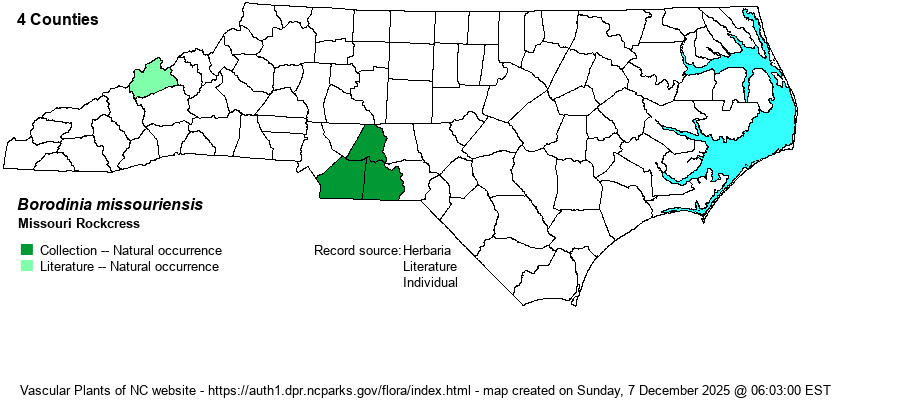| Author | (Greene) P.J. Alexander & Windham | |
| Distribution | Known to occur only in the southern Piedmont, generally close to the Rocky River and tributaries; plus one site in the Mountains in Madison County.
This species has a highly disjunct range in the Eastern and central states. It ranges from ME and WI south to GA and OK, but is absent from large areas in the middle of the range, such as VA, WV, and TN. | |
| Abundance | Rare and local in the tri-county, Slate Belt area of Stanly, Union, and Anson counties; extremely rare elsewhere, with just one other known site. This is a Significantly Rare species. | |
| Habitat | This species usually grows on steep and exposed rocky slopes and bluffs, mainly over slate in the Piedmont. In general, it grows on high pH soil around steep bluffs, at times in places difficult to reach by biologists. | |
| Phenology | Blooms in April and May, and fruits from May to June. | |
| Identification | This species is rather similar to B. laevigata, in that it grows to about 2-3 feet tall, but it is a bright green plant that is not glaucous blue-green as in the other species. Also, its lower stem leaves are pinnately lobed, as are the basal leaves; the other species may have leaves slightly serrated, but not clearly with small lobes. The stem leaves are shorter in this species, usually no more than 2 inches long (B. laevigata has leaves 3-4 inches long), and the petals are creamy white and longer, yielding a larger flower in B. missouriensis. In general, this is a bright chartreuse green plant with strongly toothed or lobed leaves, not at all hard to identify when first seen. | |
| Taxonomic Comments | In older references, it was generally considered as a variety of Arabis laevigata, which was then moved to Boechera. Weakley (2020) moved the Boechera species to Borodinia.
| |
| Other Common Name(s) | Green Rockcress | |
| State Rank | S1S2 | |
| Global Rank | G5 | |
| State Status | SR-D | |
| US Status | | |
| USACE-agcp | | |
| USACE-emp | | |

